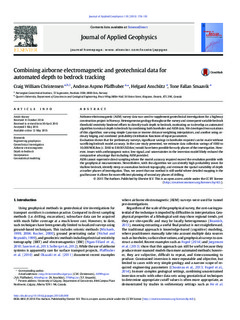| dc.description.abstract | Airborne electromagnetic (AEM) survey data was used to supplement geotechnical investigations for a highway construction project in Norway. Heterogeneous geology throughout the survey and consequent variable bedrock threshold resistivity hindered efforts to directly track depth to bedrock, motivating us to develop an automated algorithm to extract depth to bedrock by combining both boreholes and AEM data. We developed two variations of this algorithm: one using simple Gaussian or inverse distance weighting interpolators, and another using ordinary kriging and combined probability distribution functions of input parameters.
Evaluation shows that for preliminary surveys, significant savings in boreholes required can be made without sacrificing bedrock model accuracy. In the case study presented, we estimate data collection savings of 1,000 to 10,000 NOK/km (c. $160 to $1,600 USD/km) would have been possible for early phases of the investigation. However, issues with anthropogenic noise, low signal, and uncertainties in the inversion model likely reduced the comparative advantage that including AEM provided.
AEM cannot supersede direct sampling where the model accuracy required exceed the resolution possible with the geophysical measurements. Nevertheless, with the algorithm we can identify high probability zones for shallow bedrock, identify steep or anomalous bedrock topography, and estimate the spatial variability of depth at earlier phases of investigation. Thus, we assert that our method is still useful where detailed mapping is the goal because it allows for more efficient planning of secondary phases of drilling. | |
